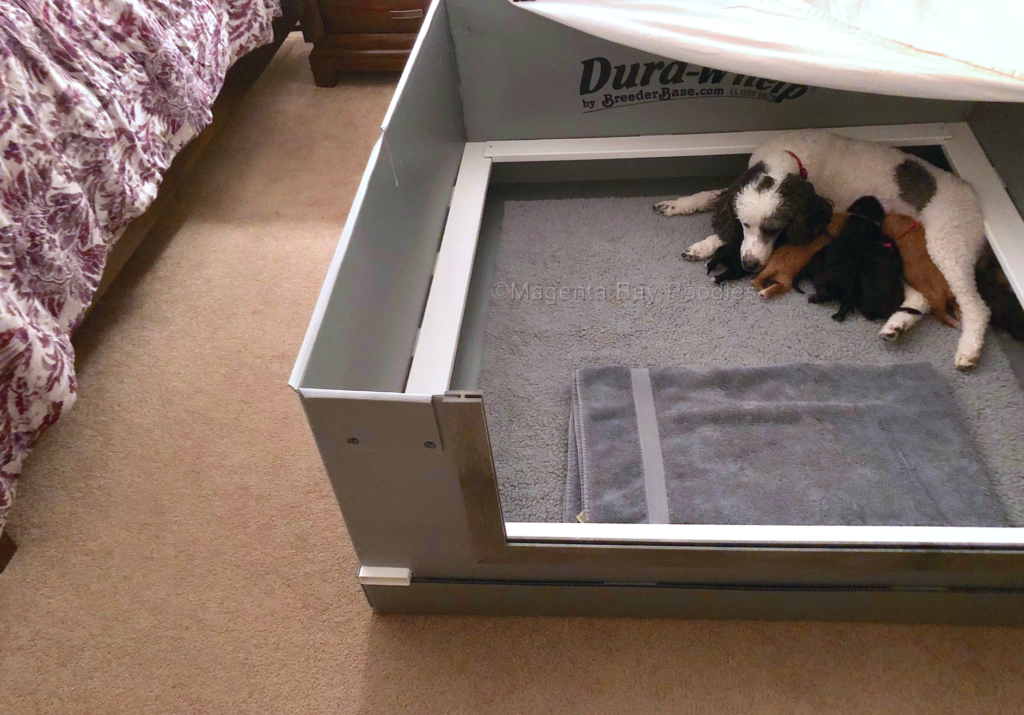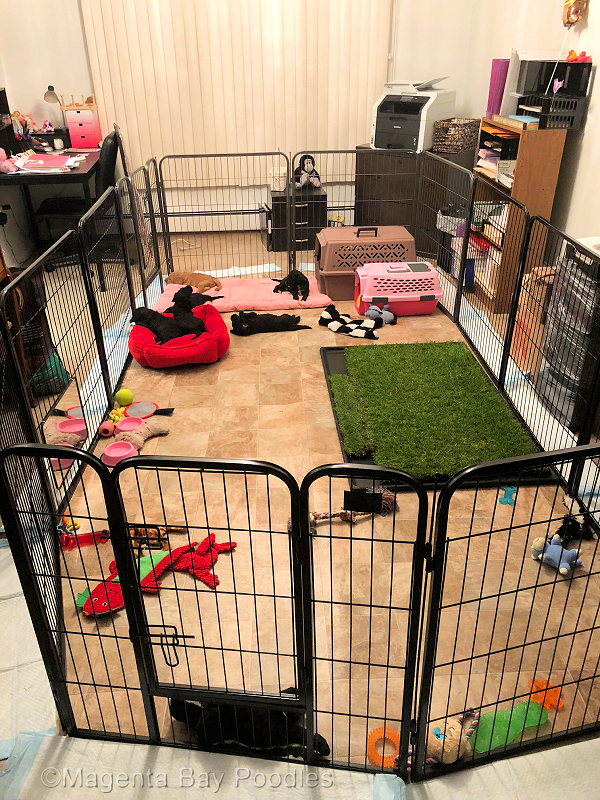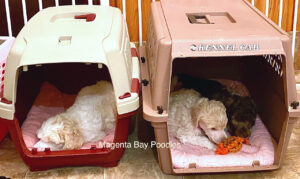Just a bit about how I raise the adorable moyen poodle puppies!
Moms are much-loved member of our household and live very much underfoot. Where I am, they are; if I’m on the couch, so are they, snoozing right next to me. If I’m on the computer, they’re lying at my feet. So of course, the puppies are VERY much part of our daily lives as well.

Pups are born in the master bedroom and are raised in the main living areas of the home. They are whelped (born) in a whelping box in my bedroom and stay there until they are 4 weeks old. This is so that I can always be near, keeping an eye on them, and, most importantly, so mom has a quiet, private place away from the general hub-bub of the household to take care of her new pups. At 4 weeks old, they are moved into the main part of the house. There they have a big area which is comprised of a sleeping area, a play area, and a potty area (see below for an example photo). They have many different toys and set ups that help to begin the confidence building so important in a stable dog. By the time you get your pup, he will have been exposed to multiple floor surfaces, things moving and swinging, loud sounds, and all normal household noises, etc. The goal is to have him learn that there’s nothing to worry about and grow to be an unafraid adult. Pups stay in our home, living underfoot, until the day you pick them up. They’ve learned all the normal household noises, sights, sounds, and smells. Puppies are never kenneled or kept in crates/cages outside the living areas of the home or anywhere away from our living area.
Birth to 16 days: Socialization & the Biosensor routine
Socialization and handling starts from birth and continues many times daily until you pick him/her up. I use the Biosensor (or “Super Dog”) routine on days 3-16. The Biosensor routine or system uses early neurological stimulation exercises to influence rapid neurological growth and development. It does not hurt at all – it mainly involves holding the pup in specific positions for 3-5 seconds. Essentially, it’s believed that this very early stimulation improves a dog’s performance as an adult, strengthens the immune system, and enables them to better handle stressful situations. (Read about it here.)
The biosensor routine has gathered some controversy about whether it really is effective or not. Honestly, I don’t know – but it is not at all harmful in any way so I’d rather do it than not. Additionally, as a trainer, it makes a lot of sense to me to be handling the puppies (safely and gently) in all different ways so they get used to everything. Highly unlikely to get a pup from me who won’t allow you to do what you need to (like, let’s say, remove something from his mouth that he’s chewing on or cutting his nails).
Birth to 4 weeks
Until about 4 weeks old, the pups are in the whelping box with their mom (in the master bedroom) and are being continually socialized and have constant contact with all of us, their mom, as well as the other dogs in the house including a very small toy poodle once mama dog allows them near the babies. If during the first 3-6ish weeks we don’t have a natural thunderstorm, I play tapes of one during mealtimes to get them used to the noise and connect it to something good (food). I further desensitize them to sounds like crying babies, sirens, trucks, fireworks, kids playing loudly, construction noises, etc. I handle the pups a lot. Not just the normal daily weighing and checks but much holding, cuddling, petting. I handle them enough so that they are, very early, getting used to being handled by humans and learning to enjoy it. I always kid that pups coming from me absolutely believe that what life is about is being cuddled and loved on. It’s all they know! The basics of potty training (as in, use a specific spot, not just where they feel like it) is started in week 2-3. During this time, pups are being exposed to vibration on their faces, feet, and bodies for east acceptance of the grooming clipper later. They continue to get their nails dremeled 2-3 times every week. Introduction to solid food starts right around 3 weeks, too!
4 weeks to 8 weeks

After they have started on solid foods (about 4 weeks old), they are moved from the whelping box to a bigger area (about 12′ by 8′) in a main area of the house where they continue to learn housebreaking and continue to build their confidence (as above). Weather permitting, I also start to take them outside for potty breaks so they learn to toilet outdoors. They learn the joys of the outdoors and they get used to the sounds that accompany it: wind, birds, airplanes, the occasional siren, etc. They always have various things to play on and with that are meant to build confidence and produce a puppy who isn’t easily frightened of new and different things. They are exposed to things like all different flooring, learn to walk over a wobble board, and conquer obstacles. (A mix of Puppy Culture and BAB techniques are used to raise all of my litters – creating a wonderfully sound and confident puppy.) Their space is set up to use their natural instincts to housebreak. Sleep, play, and potty areas are all in separate areas. They learn very quickly to go away from where they eat and sleep to do their business. This helps you tremendously with housebreaking. As to potty area here, they primarily go on pads covered with a grate, but they are also always exposed to grass so that they learn to potty on the surface that the huge majority of people will expect their pups to go on.
When the pups move into the big pen around 4 weeks, in addition to their many toys and other enrichment items, they are given an “adventure box” to play with when supervised. An adventure box is made from PVC pipe and has various safe things hanging from all four sides. As the pups play in, around, and through it, it builds confidence by getting them used to swinging things; noisy, clanging things; and general chaos around them in a fun way.
Safe cleaning is done with the pups IN the pen. This gets them completely used to things that you are going to do in your home like mopping as well as vacuuming! Most of my pups leave me thinking the vacuum is one huge toy to be chased and/or ridden!

Pups have crates (with no doors) in their big pen and most love climbing in the crate to sleep. In weeks 6 and 7, I begin proper crate training. What that means is getting them used to being in a crate with a door and being closed in for short periods of time. They learn first together with a littermate, then alone. This gives you a puppy who is already used to the idea of a crate, and being closed in by himself, so you have a huge jumpstart on crate training when he comes home.
Bathing, brushing, and grooming are started early. Poodles will need to be groomed every 4-6 weeks for the rest of their lives, so it’s super important that they begin getting used to it as pups. Each time they are washed up, the blow dryer is used so they begin to accept it. From about a week old, I begin getting the pups used to the feel of vibration on their face, body, and feet in preparation for having all those areas groomed with a clipper. Your pup will have had a “mini groom” (that’s a bath, blowdry and face, feet, and fanny/sanitary area shaved) a full three times before you take him home. Their nails are trimmed 2-3 times weekly every single week from the very first week of life. Your puppy will be well used to a dremel (nail grinder) to trim her nails by the time you bring her home; making it super easy if you want to continue that superior way to trim nails!
Obedience training happens informally in the course of living with the pups. Remember, I’ve been a trainer for a long time, so it’s just sort of natural to be teaching obedience and manners to the dogs I’m living with. Manners are paramount: mouthing and jumping on people is discouraged, but good behavior like sit for your food bowl and early basic obedience (like Sit, Come, Look) are all absolutely encouraged and you should find that your pup already has a decent handle on most or all of those when you pick him or her up.(Sometimes fun stuff too, like give paw!)
Going Home
By the time your pup is ready to go home with you, he/she has been exposed to – and is used to – all the sounds and activities of a house, going away from sleep/play/eating area to a potty spot and holding it until they get there, occasionally toileting outside on leash (weather permitting), being in a crate, coming when called, sitting when asked, responding to “no biting” and “off” (no jumping). Plus, he or she has been handled and loved far more than words can say. Between the superior genetics for health and temperament that your pup carries, all the enrichment that I feel is so necessary in creating a confident pup, and the upbringing he/she receives from me and everyone in my household, you have the makings of an amazingly stable, confident, happy pup. The first 16 weeks of a pup’s life are the most important for brain development and learning to live well and confidently in the world. I will have done all I can for the first half of that. The second half is up to you! 🙂
(Read more about what you need on the Supply List page and the Resources and Links page!)
